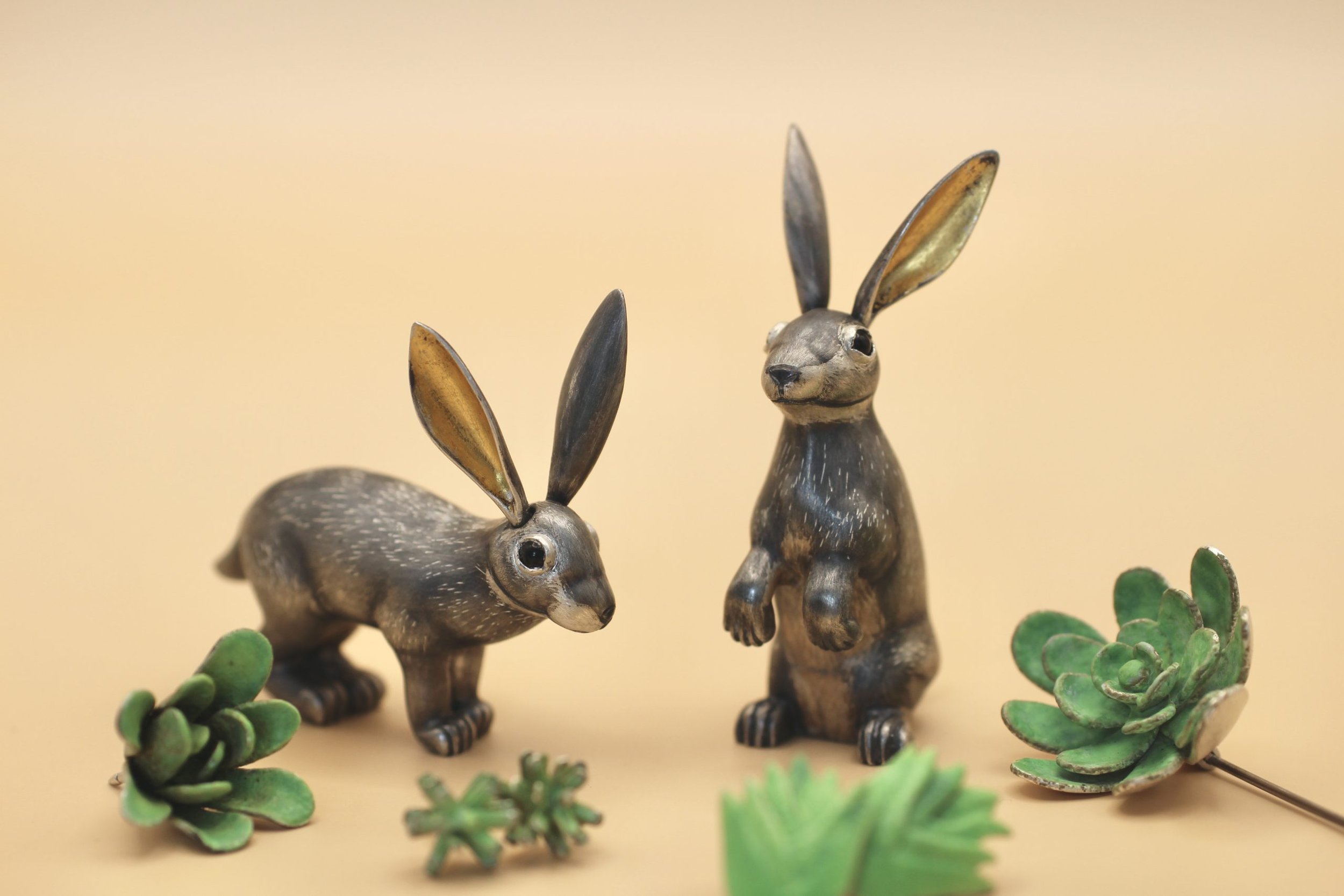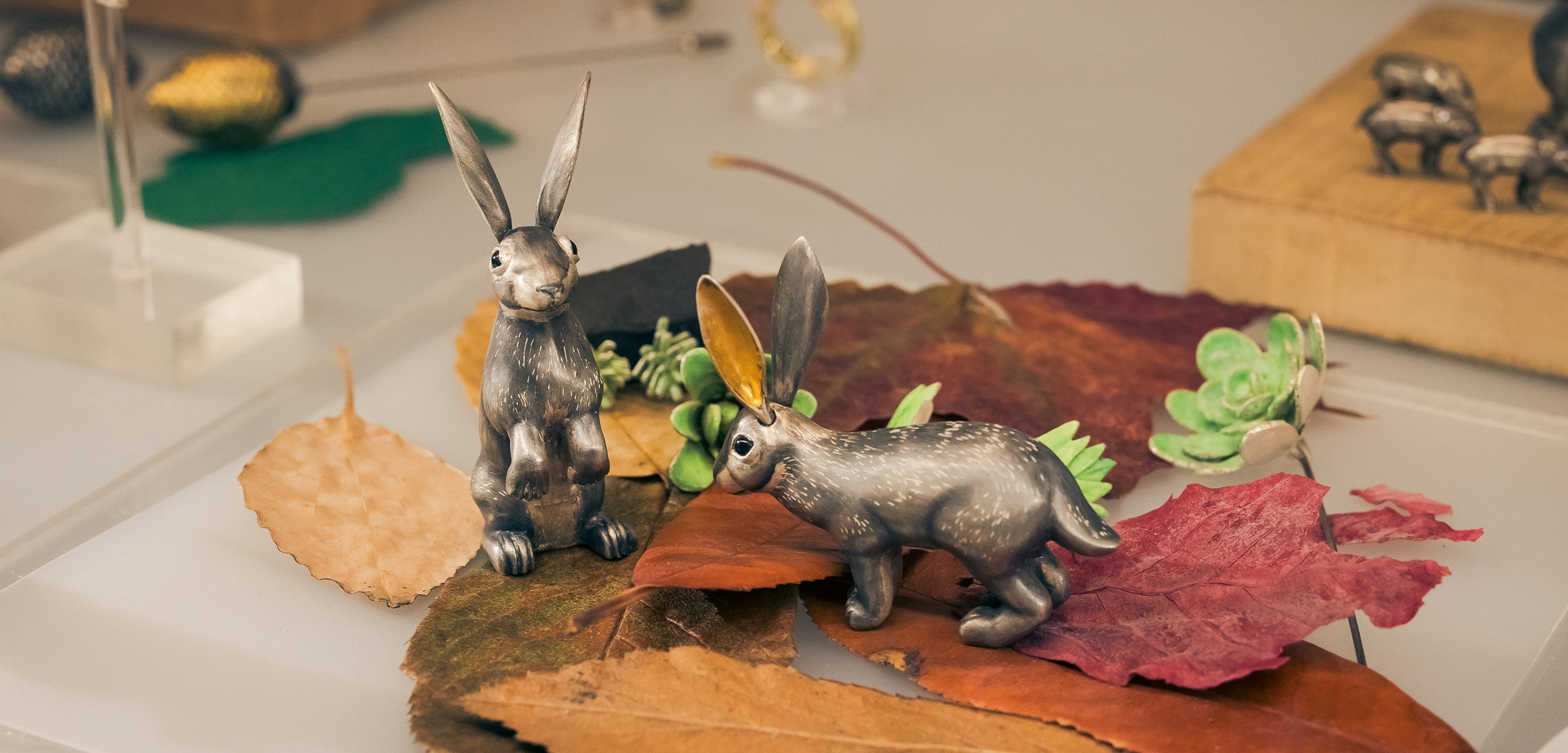Rie Taniguchi: Shining a light on endangered species
Rie Taniguchi is a Japanese born, British based artist who specialises in depictions of endangered “and under-appreciated” animals in precious metals and stones, predominantly Britannia silver. For Goldsmiths’ Stories she talked to writer Kate Matthams about raising awareness through art, and a lifelong interest in all creatures great and small.
A silver mouse hangs between two stalks, all four sets of tiny claws gripping tightly, underneath a seed pod that’s nearly as big as he is. His fur is reddish brown, his tail is wound tightly around the bottom of one of the stalks, and his onyx eyes are alert, as if he’s ready to scamper away at the first sign of danger. He makes for a cute little mouse pin, but as his maker Rie Taniguchi is telling me, most of all he’s a powerful symbol of the need to raise awareness around conservation and the preservation of natural habitats. He’s a harvest mouse, recreated down to the texture of his fur; a mammal rendered lively and graceful in Britannia silver, that also carries an important message: some species of harvest mouse have now seen up to 90% of their natural habitat lost to development.
Taniguchi is an artist who specialises in depictions of endangered “and under-appreciated” animals in precious metals and stones, predominantly silver. “I don’t consider myself a jeweller. I make objects, some are wearable, others aren’t,” she tells me. “I’m drawn to representing endangered wildlife because I believe it’s very important; there are too many people who just don’t care. In nature, Homo Sapiens is just one large mammal, but our habitats are taking over from other species.” She believes that raising awareness through her art, one collector at a time, could be the start of an awakening and is troubled by the thought that there may be some species which were never discovered by the time they became extinct. “There are so many animals that the majority of people don’t even know exist. If you don’t know, you don’t care,” she declares.
Born in Nagoya, in Japan, Taniguchi has been based in London since 1989, when she arrived to study Art & Design at what was then known as the City of London Polytechnic. She stayed on to do Extended Studies in silversmithing, during which she had a lightbulb moment: “As a child, I was always drawing, I just never stopped. During my Extended Studies, I realised I might be able to put my childhood experiences to work. I looked at industrial design, architecture, interior design and graphic design, before I came back to wildlife and began to consider it for my creative practice.” She doubled down on her craft, with an MA in Silversmithing, Jewellery, and Applied Craft at London Guildhall University, after which she was awarded support from the Craft Council’s Setting Up scheme to begin making art.
“I remember a welding workshop opening near my home, when I was little. I didn’t know what it was and was too shy to go and ask, but the idea of transforming something cold and hard into a new form; making new shapes with fire, fascinated me.” Although she never had the chance to try metalwork at school, she gravitated towards it during her studies in London, making jewellery and eventually sculptural objects in a continuation of the drawings of her childhood. Her work is figurative, just as her drawing and sketches always have been, because she believes that her subjects are already “perfectly designed and balanced, so I don’t feel that needs changing.” As most of her inspiration is so hard to find in the wild, she works from pictures she sources on the Internet, spending hours researching each animal and gathering views from different angles. “I have never seen them in real life,” she laughs, “the availability of the Internet really changed my video and picture research, which was much more difficult before. I’m able to make 2D pictures into 3D objects, which is the opposite to what people expect an artist to do.”
One of the biggest pieces she has made, is a 30cm long silver whale, with a graceful, smooth body, ridged fins and gold tubercles on his nose. Designed as a protest against the hunting of marine animals, the sculpture took months of work and she even crafted a wooden boat to display it in. “I like making bigger things and am probably most proud of this piece, but they are harder to sell so I have worked on a smaller scale for the past few years,” she tells me.
From the world’s largest mammal, she moved on to one of its smallest life forms for a recent miniature sculpture project with The Scottish Gallery, which saw her make a minute, 3cm patch of slime mould, slick in silver and pearl. Another miniature sculpture was a tiny a countrysides scene of a leaf, mushrooms and a springtail in enamelled copper, all of which fitted into 5cm cubed. “I’m interested in all lifeforms; I’ve been into tiny fungi and slime mould recently. I look at everything, I haven’t made otters yet, so I would like to do a giant river otter from the Amazon, or pink dolphins. Another one, is the endangered Ethiopian wolf. They are not closely related to the grey wolves native to Europe and North America, they have reddish fur with white markings and long legs.”
The wolf sounds like a fitting subject, but how to start? After a period of comprehensive Internet-based research, Taniguchi makes directly with the metal, press-forming to create shapes using pressure. Larger pieces require a paper model, then a copper prototype to work out how much silver will be needed and how the metal is likely to behave, before she gets to work with sheets of silver and silver wire. She usually makes each piece in two halves and solders them together to form a coherent whole ;and despite being a much longer process than wax carving and casting, she enjoys the physicality of the metalwork. “The fur and skin are the very last touches, for which I use files and engraving. For my rhinos, I leave some of the hammered texture in the silver, as they don’t have much hair.” Colour is created by painting on an oxidising solution, and engraving individual hairs on top to reveal a paler shade of silver beneath. She repeats the process until she has the depth required for the animal’s pelt, or the texture of its coat, until a bird of prey has coppery wings and perfect white wing tips, as his gold-plated talons grip a branch. Elsewhere, a rare flat-headed cat shows its pink lips in a snarl, gold-plated ears pushed back and citrine eyes glittering.
From press-forming to engraving, her creative practice ranges ever wider. After learning gemstone carving under the award-winning artist-jeweller Charlotte de Syllas, she made a pair of hornbills, certain Asian varieties of which are threatened with extinction. With a blazing red and gold bill, the male flies towards the female with a gemstone seed in his mouth. The skin of his red jasper neck falls in folds, while his partner’s is carved from turquoise, as she waits for him, with her tail feathers neatly folded. Gold, silver and copper metalwork, enamel and wood all come into play, in a vivid and graceful sculpture. “I use whichever technique is needed to achieve the right form; the making process as a whole is what’s important,” she explains when I enquire as to her favourite methods. But there is no question as to her signature material; Britannia silver. Unlike sterling silver, which is too hard; and fine silver, which is too soft; Britannia silver takes both press-forming and hammering very effectively.
This year, Year of the Rabbit according to the Chinese zodiac, she has made two endangered South African riverine rabbits. The insides of their expressive ears are gold-plated, and their fur is suggested with quick, precise strokes of the graver. “People think they are cute little bunnies. They like to look at the animals, but they don’t necessarily want to know the darker side of my work. I explain that it’s a very specific species that’s endangered,” she says. “But if they are drawn to a particular animal, they usually listen and want to know the story behind it. And that’s a good start to raising awareness.”
Written by Kate Matthams








